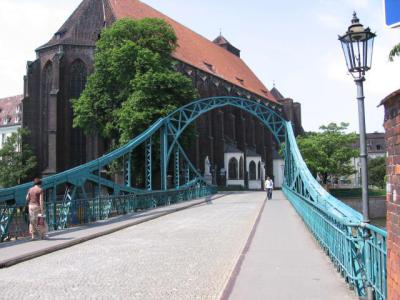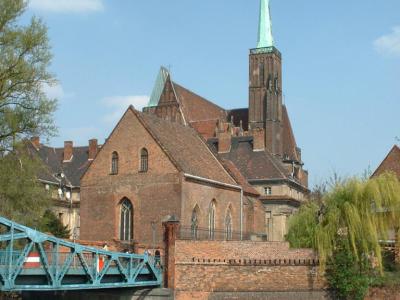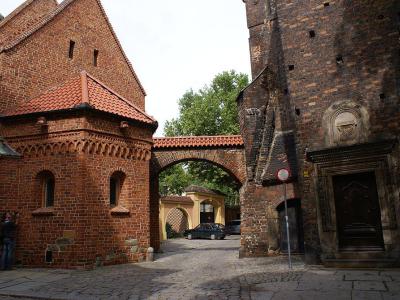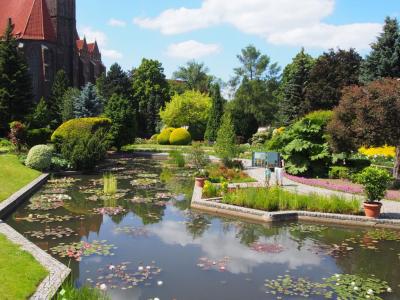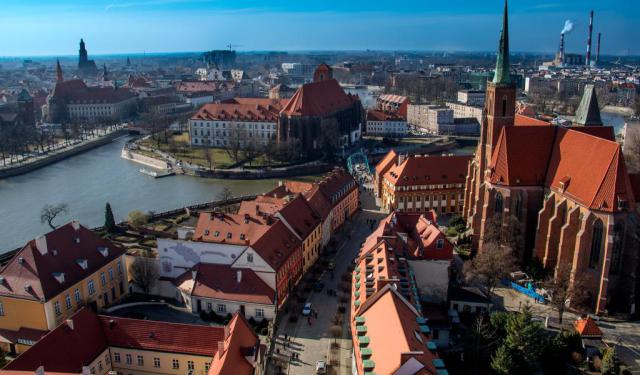
Cathedral Island Walking Tour (Self Guided), Wroclaw
Cathedral Island, known as "Ostrów Tumski" in Polish, is a historic and enchanting district in the heart of Wroclaw. This picturesque island, nestled amid the Oder River, is a treasure trove of architectural and cultural wonders that date back centuries.
Begin your journey by crossing the iconic Tumski Bridge. It's not just a pathway but a symbol of love, as couples often attach padlocks to its rails to signify their eternal bond.
Right beside the bridge stands a magnificent baroque cathedral, St. Peter and Paul's Church, housing a collection of impressive religious relics.
Further ahead, find the John of Nepomuk Monument paying homage to a revered saint known for his commitment to confidentiality.
Saint Martin's Church, with its Gothic architecture, is another sight to behold. Nearby, the medieval Castle draws history enthusiasts with its intriguing past.
The Wroclaw Cathedral, also known as Saint John the Baptist Cathedral, dominates the island's skyline. It's a masterpiece of Gothic architecture, home to stunning stained glass windows and an awe-inspiring interior.
The charming Church of Saint Giles is a hidden gem, featuring intricate frescoes and a serene atmosphere that invites quiet contemplation.
For a touch of nature, explore the Botanical Gardens on the island. It's a peaceful oasis showcasing a diverse collection of plant species.
Cathedral Island is a place whose timeless charm leaves many in awe of the past and present. Don't miss the opportunity to explore this unique district yourself when visiting Wroclaw. Your journey through the island will be a memory worth cherishing!
Begin your journey by crossing the iconic Tumski Bridge. It's not just a pathway but a symbol of love, as couples often attach padlocks to its rails to signify their eternal bond.
Right beside the bridge stands a magnificent baroque cathedral, St. Peter and Paul's Church, housing a collection of impressive religious relics.
Further ahead, find the John of Nepomuk Monument paying homage to a revered saint known for his commitment to confidentiality.
Saint Martin's Church, with its Gothic architecture, is another sight to behold. Nearby, the medieval Castle draws history enthusiasts with its intriguing past.
The Wroclaw Cathedral, also known as Saint John the Baptist Cathedral, dominates the island's skyline. It's a masterpiece of Gothic architecture, home to stunning stained glass windows and an awe-inspiring interior.
The charming Church of Saint Giles is a hidden gem, featuring intricate frescoes and a serene atmosphere that invites quiet contemplation.
For a touch of nature, explore the Botanical Gardens on the island. It's a peaceful oasis showcasing a diverse collection of plant species.
Cathedral Island is a place whose timeless charm leaves many in awe of the past and present. Don't miss the opportunity to explore this unique district yourself when visiting Wroclaw. Your journey through the island will be a memory worth cherishing!
How it works: Download the app "GPSmyCity: Walks in 1K+ Cities" from Apple App Store or Google Play Store to your mobile phone or tablet. The app turns your mobile device into a personal tour guide and its built-in GPS navigation functions guide you from one tour stop to next. The app works offline, so no data plan is needed when traveling abroad.
Cathedral Island Walking Tour Map
Guide Name: Cathedral Island Walking Tour
Guide Location: Poland » Wroclaw (See other walking tours in Wroclaw)
Guide Type: Self-guided Walking Tour (Sightseeing)
# of Attractions: 7
Tour Duration: 1 Hour(s)
Travel Distance: 0.7 Km or 0.4 Miles
Author: nataly
Sight(s) Featured in This Guide:
Guide Location: Poland » Wroclaw (See other walking tours in Wroclaw)
Guide Type: Self-guided Walking Tour (Sightseeing)
# of Attractions: 7
Tour Duration: 1 Hour(s)
Travel Distance: 0.7 Km or 0.4 Miles
Author: nataly
Sight(s) Featured in This Guide:
- Most Tumski (Tumski Bridge)
- Kosciol Sw. Piotra i Sw. Pawla (Church of St. Peter and St. Paul)
- Pomnik Sw. Jana Nepomucena (Monument of St. John of Nepomuk)
- Kosciol Sw. Marcina (St. Martin's Church)
- Katedra Wroclawska (Wroclaw Cathedral)
- Kosciol Sw. Idziego (Church of St. Giles)
- University of Wroclaw Botanical Garden
1) Most Tumski (Tumski Bridge)
Tumski Bridge stands as a historical steel bridge gracefully spanning the northern branch of the Oder River in Wrocław. Its construction dates back to the year 1889, when it replaced an older wooden bridge, forging a vital link between Ostrów Tumski and Wyspa Piaskowa.
In its earlier days, until the year 1945, Tumski Bridge was known by the name "Dombrücke." While once serving as a road bridge, it has since evolved into a charming pedestrian-only crossing, offering an enchanting experience to those who traverse its path.
Tumski Bridge is bestowed with several endearing monikers, each emblematic of its unique character and significance. Often referred to as "Lovers Bridge," "Cathedral Bridge," or even "Green Bridge," it has become a cherished venue for lovers and romantic souls. The bridge is adorned with an array of love locks, affectionately left behind by couples as a symbol of their enduring affection. A cherished tradition accompanies this act, wherein the key to the lock is ceremoniously thrown into the flowing waters of the Odra River, signifying an unbreakable bond.
In 1992, Tumski Bridge underwent a comprehensive renovation, ensuring its structural integrity and longevity. During this meticulous restoration process, the original deck covering of the Zores sections was replaced with an orthotropic deck, blending modern engineering with its timeless charm.
In its earlier days, until the year 1945, Tumski Bridge was known by the name "Dombrücke." While once serving as a road bridge, it has since evolved into a charming pedestrian-only crossing, offering an enchanting experience to those who traverse its path.
Tumski Bridge is bestowed with several endearing monikers, each emblematic of its unique character and significance. Often referred to as "Lovers Bridge," "Cathedral Bridge," or even "Green Bridge," it has become a cherished venue for lovers and romantic souls. The bridge is adorned with an array of love locks, affectionately left behind by couples as a symbol of their enduring affection. A cherished tradition accompanies this act, wherein the key to the lock is ceremoniously thrown into the flowing waters of the Odra River, signifying an unbreakable bond.
In 1992, Tumski Bridge underwent a comprehensive renovation, ensuring its structural integrity and longevity. During this meticulous restoration process, the original deck covering of the Zores sections was replaced with an orthotropic deck, blending modern engineering with its timeless charm.
2) Kosciol Sw. Piotra i Sw. Pawla (Church of St. Peter and St. Paul)
Saint Peter and Paul's Church, nestled on Ostrów Tumski, is a resilient testament to the enduring spirit of faith and architecture. As one crosses Tumski Bridge from Wyspa Piasek (Sand Island), this Gothic brick church stands as the first welcoming edifice on this historic island.
The origins of this impressive structure date back to the early 15th century, with the original construction spanning nearly half a century, from 1404 to 1452. However, fate dealt the church a series of challenges. Two fires ravaged its architecture, leading to extensive reconstruction efforts. Tragically, during the turbulent times of Festung Breslau, the church endured further devastation, with approximately 40% of its structure reduced to ruins.
In the aftermath of these trials, the resilient spirit of Saint Peter and Paul's Church prevailed. The church experienced a rebirth in the 1950s, marking a significant chapter in its history. However, the accuracy of the interior's restoration has been a subject of debate and discussion among scholars and enthusiasts.
Visitors to the church may find its front doors open at various times, often depending on the whims of the resident priest. As a general guideline, the church tends to be accessible from 8:00 to 16:00, Monday through Friday. However, for those seeking a more detailed exploration of its architectural and spiritual treasures, advance arrangements are often necessary.
The Gothic structure of Saint Peter and Paul's Church features a distinctive design, characterized by a two-aisle layout. The square nave, measuring 24 by 14 meters, stands as the central space of worship. Adjacent to it is a three-bay, three-sided chancel, measuring 9.7 by 5.9 meters, extending to the east. The church's roofing features two gable roofs, with the presbytery part adorned with multi-sloped roofing. A staircase turret graces the northern corner of the chancel and nave.
The façades of the nave are characterized by their smooth and graceful lines, while the chancel and the northern wall of the nave are strengthened by buttresses, providing architectural stability and character. Inside, the nave boasts a stellar vault, elegantly supported by a central pillar and buttresses built within the structure. Originally, the chancel featured a cross-rib vault, delineated into six sections in the eastern closure.
The origins of this impressive structure date back to the early 15th century, with the original construction spanning nearly half a century, from 1404 to 1452. However, fate dealt the church a series of challenges. Two fires ravaged its architecture, leading to extensive reconstruction efforts. Tragically, during the turbulent times of Festung Breslau, the church endured further devastation, with approximately 40% of its structure reduced to ruins.
In the aftermath of these trials, the resilient spirit of Saint Peter and Paul's Church prevailed. The church experienced a rebirth in the 1950s, marking a significant chapter in its history. However, the accuracy of the interior's restoration has been a subject of debate and discussion among scholars and enthusiasts.
Visitors to the church may find its front doors open at various times, often depending on the whims of the resident priest. As a general guideline, the church tends to be accessible from 8:00 to 16:00, Monday through Friday. However, for those seeking a more detailed exploration of its architectural and spiritual treasures, advance arrangements are often necessary.
The Gothic structure of Saint Peter and Paul's Church features a distinctive design, characterized by a two-aisle layout. The square nave, measuring 24 by 14 meters, stands as the central space of worship. Adjacent to it is a three-bay, three-sided chancel, measuring 9.7 by 5.9 meters, extending to the east. The church's roofing features two gable roofs, with the presbytery part adorned with multi-sloped roofing. A staircase turret graces the northern corner of the chancel and nave.
The façades of the nave are characterized by their smooth and graceful lines, while the chancel and the northern wall of the nave are strengthened by buttresses, providing architectural stability and character. Inside, the nave boasts a stellar vault, elegantly supported by a central pillar and buttresses built within the structure. Originally, the chancel featured a cross-rib vault, delineated into six sections in the eastern closure.
3) Pomnik Sw. Jana Nepomucena (Monument of St. John of Nepomuk)
John of Nepomuk, a revered saint, renowned for his role in safeguarding against the perils of floods, held particular importance in a city graced with an intricate network of waterways. Born in the 14th century in Pomuk (later renamed Nepomuk), was a Christian presbyter and the confessor of Queen Sophia of Bavaria. His life took a fateful turn when, as the keeper of royal confessions, he faced a perilous dilemma. Refusing to disclose the queen's secrets to her husband, Wenceslaus IV of Bohemia, John met a tragic end, cast into the unforgiving waters of the Vltava River.
The statue of John of Nepomuk that now stands proudly on Ostrów Tumski was meticulously crafted between 1730 and 1732. The skilled hands responsible for this masterpiece belonged to Bohemian-German sculptor Johann Georg Urbansky, who brought to life a design conceived by Christoph Tausch.
Upon closer inspection, one may notice a charming and somewhat peculiar detail on this monument. Two of the cherubs adorning the figure are depicted as bald, in contrast to the typical representation of cherubs with a full head of (presumably golden) curls. This whimsical touch carries an endearing story with it. It is said that Urbansky's assistant, tasked with sculpting the final cherub heads, was inspired by the arrival of his hairless newborn son. To commemorate this special occasion, he decided to immortalize his baby's likeness among the celestial choir of angels. Initially met with his boss's ire, the sculptor's audacious act eventually won over Urbansky's heart, prompting him to grant a second cherub a buzz cut to maintain symmetry.
The statue of John of Nepomuk that now stands proudly on Ostrów Tumski was meticulously crafted between 1730 and 1732. The skilled hands responsible for this masterpiece belonged to Bohemian-German sculptor Johann Georg Urbansky, who brought to life a design conceived by Christoph Tausch.
Upon closer inspection, one may notice a charming and somewhat peculiar detail on this monument. Two of the cherubs adorning the figure are depicted as bald, in contrast to the typical representation of cherubs with a full head of (presumably golden) curls. This whimsical touch carries an endearing story with it. It is said that Urbansky's assistant, tasked with sculpting the final cherub heads, was inspired by the arrival of his hairless newborn son. To commemorate this special occasion, he decided to immortalize his baby's likeness among the celestial choir of angels. Initially met with his boss's ire, the sculptor's audacious act eventually won over Urbansky's heart, prompting him to grant a second cherub a buzz cut to maintain symmetry.
4) Kosciol Sw. Marcina (St. Martin's Church)
Saint Martin's Church, a modest and somewhat uniquely shaped brick structure, serves as a poignant remnant of the Piast dynasty's 13th-century Royal Castle, once proudly situated on the island of Ostrów Tumski. This venerable church, however, has seen its fair share of transformations over the centuries, with significant reconstructions occurring in both the 15th and 20th centuries.
Before delving into its architectural history, it is essential to recognize the pivotal role Saint Martin's played in the cultural tapestry of the city. In a predominantly German city before World War II, this church held the distinction of being a vibrant center of Polish culture. Here, Poles congregated to partake in sermons and hymns delivered in their native language, fostering a sense of community and heritage. The church also bore witness to a poignant chapter in Polish history, as it hosted the last Polish mass under the oppressive rule of the Nazis in 1939.
A commemorative plaque adorning the exterior of Saint Martin's poignantly reminds visitors of this historical significance, bearing the inscription: "We are Poles... A Pole is a brother to a Pole... Poland is our mother, we cannot speak badly of our mother."
Standing sentinel outside Saint Martin's Church is a monumental tribute to Pope John XXIII, erected in 1986, serving as a symbol of the enduring faith and spiritual legacy of the church and its community.
The history of Ostrów Tumski is intertwined with the castle that once stood here. The 12th and 13th-century brick castle, constructed atop the foundations of an earlier stronghold dating back to the 10th century, has left only a handful of remnants. Chief among them is the church of Saint Martin, which, though severely damaged, stands as a testament to the enduring spirit of faith and culture in Wrocław.
Before delving into its architectural history, it is essential to recognize the pivotal role Saint Martin's played in the cultural tapestry of the city. In a predominantly German city before World War II, this church held the distinction of being a vibrant center of Polish culture. Here, Poles congregated to partake in sermons and hymns delivered in their native language, fostering a sense of community and heritage. The church also bore witness to a poignant chapter in Polish history, as it hosted the last Polish mass under the oppressive rule of the Nazis in 1939.
A commemorative plaque adorning the exterior of Saint Martin's poignantly reminds visitors of this historical significance, bearing the inscription: "We are Poles... A Pole is a brother to a Pole... Poland is our mother, we cannot speak badly of our mother."
Standing sentinel outside Saint Martin's Church is a monumental tribute to Pope John XXIII, erected in 1986, serving as a symbol of the enduring faith and spiritual legacy of the church and its community.
The history of Ostrów Tumski is intertwined with the castle that once stood here. The 12th and 13th-century brick castle, constructed atop the foundations of an earlier stronghold dating back to the 10th century, has left only a handful of remnants. Chief among them is the church of Saint Martin, which, though severely damaged, stands as a testament to the enduring spirit of faith and culture in Wrocław.
5) Katedra Wroclawska (Wroclaw Cathedral)
The Cathedral of Saint John the Baptist in Wrocław serves as the seat of the Roman Catholic Archdiocese of Wrocław and an iconic symbol of the city in Poland. Located in the historic Cathedral Island district, this cathedral is a prime example of Gothic architecture with later Neo-Gothic additions, marking the fourth church to grace this hallowed site.
The cathedral, along with the Old Town of Wrocław, has been rightly honored as a Historic Monument of Poland. Its rich history traces back to the mid-10th century when the first church was erected during the Přemyslid rule, characterized by its fieldstone construction featuring a single nave, a distinctive transept, and an apse, stretching about 25 meters (82 feet) in length. This initial structure was, however, succeeded by a more substantial basilical church with three naves, crypt, and eastern towers, following the Polish conquest of Silesia and the establishment of the Wrocław diocese under Duke Bolesław I Chrobry in 1000.
The ravages of time and historical events took their toll, leading to the destruction of the first cathedral, possibly during the invasion of Duke Bretislaus of Bohemia around 1039. In its stead, a grand Romanesque-style church was erected during Duke Casimir I's era. Subsequent to the conclusion of the first Mongol invasion of Poland, the cathedral underwent significant reconstruction in the prevailing Brick Gothic style that endures today.
Notably, the cathedral's interior boasts several chapels of profound historical and artistic significance. The Chapel of Saint Elizabeth, located in the southern section, was constructed between 1682 and 1700 as a mausoleum for Bishop Frederick of Hesse-Darmstadt. This sacred space is dedicated to Saint Elizabeth of Hungary, a venerated figure in Wrocław's medieval history.
Another prominent feature is the Gothic Marian Chapel, found just behind the choir, constructed by architect Peschel on the orders of Bishop Przecław of Pogorzela between 1354 and 1365. It houses not only the tomb of its founder but also that of Bishop Johann IV Roth, a masterpiece crafted by Peter Fischer the Elder of Nuremberg. To the north, the Baroque Elector's Chapel, also known as the Chapel of Corpus Christi, was built from 1716 to 1724. This chapel serves as the mausoleum of Bishop Count Palatine Francis Louis of Neuburg and showcases exquisite decorative paintings by Carlo Carlone and sculptures by Ferdinand Brokoff.
One of the cathedral's crowning achievements is its magnificent pipe organ, the largest in Poland. This awe-inspiring instrument was crafted in 1913 by E.F. Walcker & Sons of Ludwigsburg, Baden-Württemberg, Germany, and was initially installed in the Centennial Hall, formerly the world's largest organ.
The cathedral, along with the Old Town of Wrocław, has been rightly honored as a Historic Monument of Poland. Its rich history traces back to the mid-10th century when the first church was erected during the Přemyslid rule, characterized by its fieldstone construction featuring a single nave, a distinctive transept, and an apse, stretching about 25 meters (82 feet) in length. This initial structure was, however, succeeded by a more substantial basilical church with three naves, crypt, and eastern towers, following the Polish conquest of Silesia and the establishment of the Wrocław diocese under Duke Bolesław I Chrobry in 1000.
The ravages of time and historical events took their toll, leading to the destruction of the first cathedral, possibly during the invasion of Duke Bretislaus of Bohemia around 1039. In its stead, a grand Romanesque-style church was erected during Duke Casimir I's era. Subsequent to the conclusion of the first Mongol invasion of Poland, the cathedral underwent significant reconstruction in the prevailing Brick Gothic style that endures today.
Notably, the cathedral's interior boasts several chapels of profound historical and artistic significance. The Chapel of Saint Elizabeth, located in the southern section, was constructed between 1682 and 1700 as a mausoleum for Bishop Frederick of Hesse-Darmstadt. This sacred space is dedicated to Saint Elizabeth of Hungary, a venerated figure in Wrocław's medieval history.
Another prominent feature is the Gothic Marian Chapel, found just behind the choir, constructed by architect Peschel on the orders of Bishop Przecław of Pogorzela between 1354 and 1365. It houses not only the tomb of its founder but also that of Bishop Johann IV Roth, a masterpiece crafted by Peter Fischer the Elder of Nuremberg. To the north, the Baroque Elector's Chapel, also known as the Chapel of Corpus Christi, was built from 1716 to 1724. This chapel serves as the mausoleum of Bishop Count Palatine Francis Louis of Neuburg and showcases exquisite decorative paintings by Carlo Carlone and sculptures by Ferdinand Brokoff.
One of the cathedral's crowning achievements is its magnificent pipe organ, the largest in Poland. This awe-inspiring instrument was crafted in 1913 by E.F. Walcker & Sons of Ludwigsburg, Baden-Württemberg, Germany, and was initially installed in the Centennial Hall, formerly the world's largest organ.
6) Kosciol Sw. Idziego (Church of St. Giles)
The Church of Saint Giles, a late Romanesque gem nestled on Ostrów Tumski, boasts a rich history that dates back to the 13th century. This venerable church holds the distinction of being not only the oldest fully preserved building in Wrocław but also the oldest active church in the city today.
The origins of this church are shrouded in the mists of time, with construction likely occurring between 1220 and 1240, although it certainly existed prior to the pivotal year of 1241. The stone profiles adorning the church's plinth bear the unmistakable stylistic characteristics of an earlier structure, suggesting that they may be spolia reclaimed from the so-called Walterowska Cathedral.
The church boasts two portals, one in the Romanesque style, and the other adorned with Renaissance elements. This structure adheres to the distinctive architectural type of single-pillar churches that were typical of medieval Wrocław. The church's vault is gracefully supported by a solitary pillar, and an intricate brick arcade connects it to the 16th-century chapter house, an exemplar of late Gothic design, thus forming the famed "Kluskowa Gate" (or "Kluszczana" in German, known as "Klösseltor").
In the aftermath of World War II, significant efforts were undertaken to restore the Church of Saint Giles to its original character. Many of the Baroque-era alterations were meticulously removed, the external plaster was stripped away, and the double chancel arch was faithfully reconstructed, preserving the church's historical essence. One notable feature that endured this process of revitalization is the enduring bell tower, which still graces the landscape.
Today, the chapter building and the neighboring structure house the Archdiocesan Museum. Within its hallowed walls, visitors can explore a treasure trove of sacred art, including valuable collections and artifacts like "The Book of Henry," an Egyptian mummy from 325 BC, and stone reliefs from the 3rd century, hailing from the Damascus area in Syria.
The origins of this church are shrouded in the mists of time, with construction likely occurring between 1220 and 1240, although it certainly existed prior to the pivotal year of 1241. The stone profiles adorning the church's plinth bear the unmistakable stylistic characteristics of an earlier structure, suggesting that they may be spolia reclaimed from the so-called Walterowska Cathedral.
The church boasts two portals, one in the Romanesque style, and the other adorned with Renaissance elements. This structure adheres to the distinctive architectural type of single-pillar churches that were typical of medieval Wrocław. The church's vault is gracefully supported by a solitary pillar, and an intricate brick arcade connects it to the 16th-century chapter house, an exemplar of late Gothic design, thus forming the famed "Kluskowa Gate" (or "Kluszczana" in German, known as "Klösseltor").
In the aftermath of World War II, significant efforts were undertaken to restore the Church of Saint Giles to its original character. Many of the Baroque-era alterations were meticulously removed, the external plaster was stripped away, and the double chancel arch was faithfully reconstructed, preserving the church's historical essence. One notable feature that endured this process of revitalization is the enduring bell tower, which still graces the landscape.
Today, the chapter building and the neighboring structure house the Archdiocesan Museum. Within its hallowed walls, visitors can explore a treasure trove of sacred art, including valuable collections and artifacts like "The Book of Henry," an Egyptian mummy from 325 BC, and stone reliefs from the 3rd century, hailing from the Damascus area in Syria.
7) University of Wroclaw Botanical Garden
The Botanical Gardens offer a delightful and tranquil escape within the heart of Ostrów Tumski, making them an essential stop on any comprehensive tour of this historic district. What began as a scientific endeavor has blossomed into a beloved haven for the city's residents and visitors alike.
The origins of these splendid gardens can be traced back to a period of diligent effort, spanning from 1811 to 1816, when they were meticulously established on the former riverbed of the Odra River, which once flowed around Ostrów Tumski. Encompassing a vast expanse of 7.4 hectares, these gardens harbor an impressive array of plant life, creating a captivating tapestry of nature's beauty.
As you wander through these meticulously manicured grounds, you'll discover more than just a diverse collection of plants. The Botanical Gardens also house enchanting aquariums that provide glimpses into the aquatic wonders of our world. Adorning the landscape are captivating sculptures that harmonize with the natural surroundings, infusing the garden with artistic charm.
For those seeking a memento of their visit or hoping to nurture their own green thumb, a plant shop awaits, offering a selection of botanical treasures to take home. If you find yourself in need of refreshment, two cozy cafes provide a serene spot to savor a beverage and savor the tranquility.
One of the focal points of these botanical wonders is a picturesque pond graced with charming bridges, adding a touch of romance to the serene ambiance. The gardens come to life seasonally, opening their gates from early April until the end of October. While occasional visits by exuberant schoolchildren may add a dash of lively energy, the vast and thoughtfully designed landscapes ensure that you can always find a quiet corner to lose yourself in the soothing embrace of nature.
The origins of these splendid gardens can be traced back to a period of diligent effort, spanning from 1811 to 1816, when they were meticulously established on the former riverbed of the Odra River, which once flowed around Ostrów Tumski. Encompassing a vast expanse of 7.4 hectares, these gardens harbor an impressive array of plant life, creating a captivating tapestry of nature's beauty.
As you wander through these meticulously manicured grounds, you'll discover more than just a diverse collection of plants. The Botanical Gardens also house enchanting aquariums that provide glimpses into the aquatic wonders of our world. Adorning the landscape are captivating sculptures that harmonize with the natural surroundings, infusing the garden with artistic charm.
For those seeking a memento of their visit or hoping to nurture their own green thumb, a plant shop awaits, offering a selection of botanical treasures to take home. If you find yourself in need of refreshment, two cozy cafes provide a serene spot to savor a beverage and savor the tranquility.
One of the focal points of these botanical wonders is a picturesque pond graced with charming bridges, adding a touch of romance to the serene ambiance. The gardens come to life seasonally, opening their gates from early April until the end of October. While occasional visits by exuberant schoolchildren may add a dash of lively energy, the vast and thoughtfully designed landscapes ensure that you can always find a quiet corner to lose yourself in the soothing embrace of nature.
Walking Tours in Wroclaw, Poland
Create Your Own Walk in Wroclaw
Creating your own self-guided walk in Wroclaw is easy and fun. Choose the city attractions that you want to see and a walk route map will be created just for you. You can even set your hotel as the start point of the walk.
Wroclaw Introduction Walking Tour
Wroclaw, the capital of Poland’s Lower Silesia province, is a travel gem for wandering hearts. Steeped in over 1,000 years of history and a vibrant blend of Polish, German, and other cultural influences, it could easily compete for the title of the most beautiful city in Europe.
The area around Wroclaw was inhabited as early as the 9th century by Slavic tribes. The town was originally part of... view more
Tour Duration: 2 Hour(s)
Travel Distance: 3.7 Km or 2.3 Miles
The area around Wroclaw was inhabited as early as the 9th century by Slavic tribes. The town was originally part of... view more
Tour Duration: 2 Hour(s)
Travel Distance: 3.7 Km or 2.3 Miles
The Most Popular Cities
/ view all
